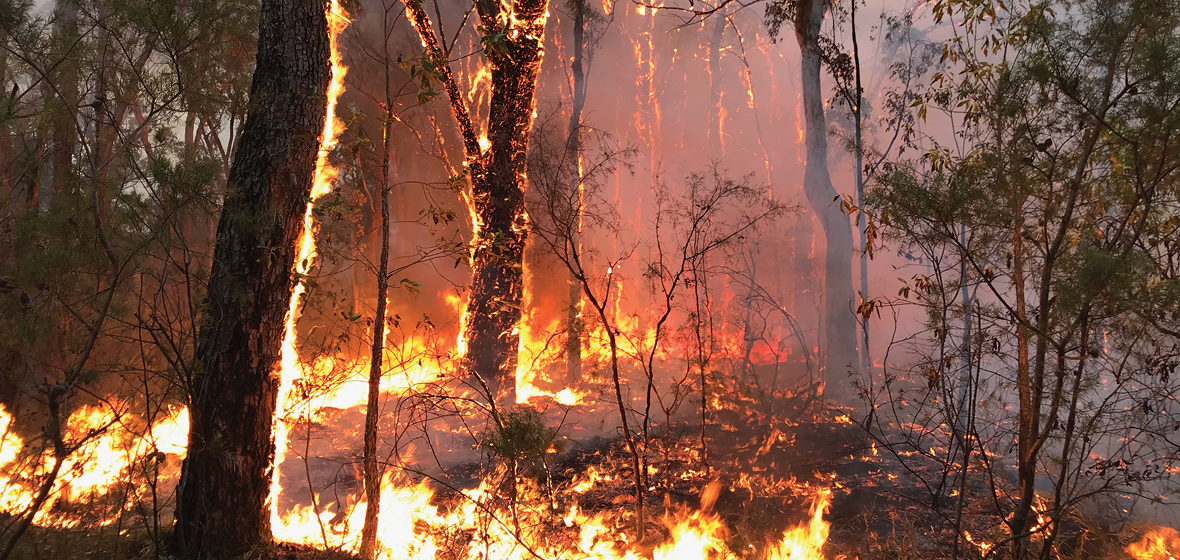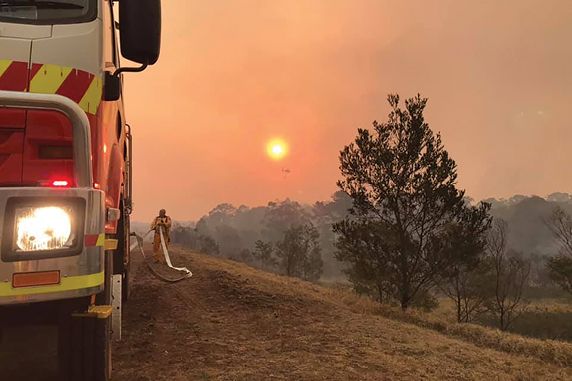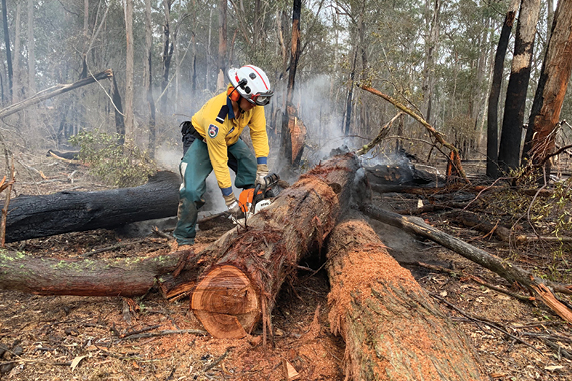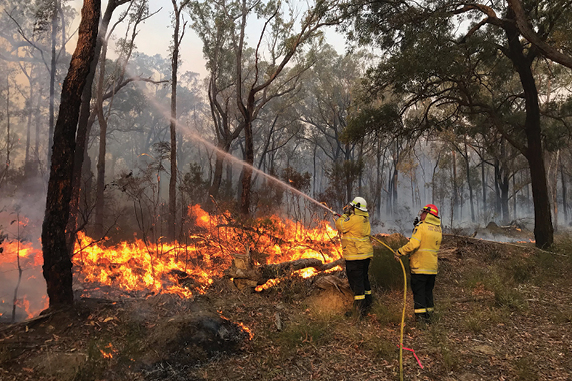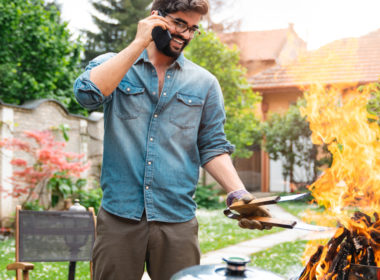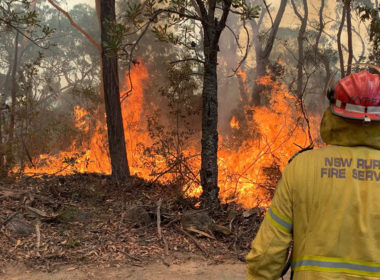Demand for free legal advice soared after the catastrophic bushfires of Australia’s 2019/20 Black Summer. One year on, lawyers are preparing to work in an increasingly volatile climate. (Photography: Lance Watson)
Lance Watson is wearing a clean shirt, sitting in his home office, and laughing about the fact he can chat on the phone knowing there’s no chance his clothes will catch fire. It’s a stark difference to 12 months ago, when the wills and estates lawyer was sooty, sweaty, and absolutely shattered.
Watson is a partner at Caldwell Martin Cox at Picton in Sydney’s southwest and volunteers as Deputy Captain of his local Rural Fire Service (RFS) brigade. He was on the front line of the state’s bushfire emergency, working up to 23 hours at a time on the back of a truck defending life and property. It was a disastrous season that saw more than 11,400 blazes burn 6.2 per cent of the state, which the Australian Institute for Disaster Resilience says was the largest burnt area recorded in a single fire season along the eastern seaboard. For weeks, he was running on a cocktail of adrenalin and Red Bull while managing his caseload – at one point even dictating emails with a hose over his shoulder – and burnout was real.
Speaking to LSJ today, however, the contrast is profound. He’s relaxed and happy. He’s not getting any more sleep though, he jokes, since he and his wife welcomed their daughter Sophie into the world in November.
“It’s fantastic,” he says of fatherhood. “It gave us something positive in the middle of everything else that 2020 threw at us. I’m still not getting any sleep, but it’s for a much nicer reason.”
The 2019/20 bushfire season was like no other, coming at the end of Australia’s hottest and driest year on record. The conditions created a perfect storm: parched soil, a large fuel load, low humidity, and strong winds. The catastrophe tragically claimed 33 lives, destroyed more than 3,000 homes, killed or displaced 3 billion animals, and racked up insurance bills totalling more than $10 billion. Every state and territory suffered in a horror season that will be forever known as “Black Summer”.
“It’s not until now that you sit back and think about the enormity of what we went through,” Watson says. “My whole life just stopped for three months, but sitting here now, my lawn is green, there’s rain falling every second day, the phone hasn’t been going off much at all with call-outs. It’s a bit surreal.”
Demand for legal advice
Swathes of Australia were still burning when the government founded the Royal Commission into National Natural Disaster Arrangements in February 2020. The panel included retired Air Chief Marshal Mark Binskin, a former Chief of the Defence Force; Annabelle Bennett, a retired Federal Court judge and former Deputy President of the Administrative Appeals Tribunal; and Professor Andrew Macintosh, the Associate Dean (Research) at the Australian National University’s Climate Change Institute.
They handed down their findings in a 594-page report, published in October.
“Unprecedented is a word used all too often to describe natural disasters,” Binskin noted in the foreword. “Australia wide, there was significant community loss, devastation of wildlife and adverse health impacts. These losses were exacerbated by severe hailstorms, and floods in some areas that were just starting to recover from the fires. Then COVID-19 hit.”
The commission heard harrowing accounts of devastation and loss, tales of bravery and camaraderie, and stories of people who were both very lucky and incredibly unlucky. A whole chapter was dedicated to the subject of insurance and natural disaster recovery efforts. The commission commended insurers and found most claims from the 2019/20 season were handled “proactively and in a timely manner” and that the number of complaints was “relatively small”. However, it also heard evidence that there was an increase in the demand for free legal advice in relation to insurance claims, which are continuing to this day, long after the ash stopped raining.
“The delivery of legal assistance services is a key example of non-government recovery support which would benefit from greater planning,” the commission reported. This includes insurance issues, family issues, tenancy issues, and social security issues, among others. NSW had no pre-agreed framework to activate a legal response, which led to a longer period of confusion for members of the public.
We’re still getting brand new clients who lost their homes as far back as November of 2019. If they’re calling us at this stage, it generally means … there has been drama after drama, and they’re at an impasse with their insurer.
Julia Davis, Financial Rights Legal Centre.
Crunching the numbers
One of the organisations leading the charge on the provision of free legal advice services is the Financial Rights Legal Centre. Its team of up to 12 lawyers provided 768 natural disaster-related legal services for 554 unique clients last season. The majority of those related to storms and hail, however 193 services were directly linked to the catastrophic bushfires. Most called because of issues with underinsurance, debris removal issues, cash settlement problems, poor claims handling, and delays.
“We’re still getting brand new clients who lost their homes as far back as November of 2019,” says Julia Davis, a lawyer who works as the centre’s Policy and Communications Officer. “If they’re calling us at this stage, it generally means the issues are really complex, there has been drama after drama, and they’re at an impasse with their insurer. Multiple people have called because their temporary accommodation entitlements are running out and their homes aren’t re-built.”
She says climate change will only make the problem worse. Severe weather patterns are making insurance premiums rise, which means more people will start opting out of things they can’t afford.
“We need to share the risk between taxpayers, insurers, and homeowners, otherwise large areas of Australia will become uninhabitable.”
The rollout of legal services will also require a team effort. Sharlene Naismith is the Senior Outreach Solicitor at the Disaster Response Legal Service division of Legal Aid NSW, based at Nowra on the south coast. A fire front came scarily close to her home in Kangaroo Valley, just west of the town, destroying several houses along her road. A steady rumble of trucks carrying building materials and landscaping supplies past her fence is a very tangible sign of recovery, but the work is a long way from being done.
Legal Aid NSW provided more than 1,000 legal services to people affected by disasters in the first half of 2020, about 30 per cent over the phone and 60 per cent at in-person recovery assistance points (until the outbreak of COVID-19). Some 65 solicitors worked 180 cumulative days in a row at the outset and the organisation is continuing to work closely with Service NSW, Resilience NSW, councils, community legal centres, and private solicitors to meet demand.
“We couldn’t improve the enthusiasm of our staff to do this work and get out there and help,” she says. “But for the future, we now have our own plan for what we’re going to do and how we’re going to consult with other stakeholders, and know we’ve got money we can access to fund a coordinated future effort instead of all working ad hoc.”
A key change, she says, has been the Bushfire Legal Aid Scheme, which helps small businesses and primary producers access legal services from private solicitors. The $8.7 million fund, provided by the Commonwealth, has been critical to ensuring sharing the burden in many regional areas.
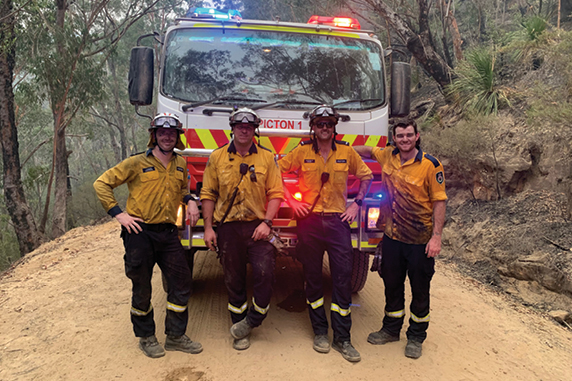
Cycles of disasters
Stuart Clark, a former partner at Clayton Utz who now works as a sole practitioner, has been a volunteer firefighter since he was in high school more than four decades ago. He’s based at Killara, on the upper north shore of Sydney, and he has had a front-row seat as the RFS evolved from a collection of local bushfire brigades into one of the largest volunteer organisations in the world. It now has almost 2,000 brigades and more than 76,000 members who attend more than 26,000 incidents per year.
Clark’s career and volunteer work have crossed paths a number of times – in his previous role, he advised the state’s emergency services in a legal capacity. He continues to be involved and his passion is clear.
“One of the great things about the RFS is that it has everybody,” he says. “There are judges and bus drivers, labourers and senior executives in major corporations. There are school kids and stay-at-home parents. It’s a wonderful thing to be able to mix with such a cross-section of the community.”
At the tail end of the bushfire season, however, he says he was “sick as a dog”. He was coughing uncontrollably from a respiratory infection he contracted through weeks of inhaling dust and ash from the back of a fire truck. Clark had just returned from a trip to Japan for the Rugby World Cup when he was deployed on a strike team to relieve local crews at Taree, on the mid-north coast. The Killara brigade worked everywhere between the Queensland and Victorian borders, running four tankers all season. There was only one blaze on their own doorstep, in Turramurra, which fortunately was quickly brought under control.
“You can’t let your guard down,” he says. “The quiet season this year has given everybody a chance to recover, and we needed that, because people physically and mentally have been through the ringer. But clearly the climate has changed, there’s no doubt about the fact that the fire seasons are getting longer around the world and conditions are becoming more intense. It comes in cycles – high rainfall assists in the recovery of areas that have burnt, but it leads to huge increases in fuel loads when it dries out.”
Preparing for the future
One of the most newsworthy aspects of the recovery process has been the release of funds donated to the RFS at the height of the crisis. Comedian Celeste Barber spearheaded a campaign that raised more than $100 million, which has paid for measures that are already being put to good use. So far, more than $30 million has been spent on life-saving equipment, $20 million has gone to station upgrades, $10 million has gone to injured firefighters, $7 million has been spent on high-tech Kevlar helmets, and $2 million has gone towards a new mobile phone app designed to streamline emergency dispatches.
Recommendations from the Royal Commission are also being put in place. The government is working on new measures including legislation that will empower the federal government to declare a national emergency and mobilise Commonwealth resources, as well as a new National Resilience, Relief and Recovery Agency dedicated to reducing the risk and ensuring effective recovery.
“While state and territory governments have primary responsibility, and accountability, for emergency management, we have concluded that Australia needs a national approach to natural disasters,” Binskin said at the time. “Effective national coordination will be a critical capability in managing natural disasters on a national scale or with national consequences. Arrangements need to be clear, robust and accountable.”
Pauline Wright, former President of the Law Council, said in a statement it’s not surprising that the Royal Commission specifically called out the importance of legal assistance in times of crisis.
“The legal profession has consistently stood up to the challenges of natural disasters through the provision of emergency support, led by the community legal sector, legal aid commissions and the pro bono contribution of private practitioners,” she said. “Outreach centres providing on-the-ground advice, telephone advice services and dedicated online and physical resources are vital to communities following disaster events and must be linked to long-term support and recovery from disasters.”
Crises inevitably leverage minimal resources to meet huge demand. A lot of work is currently underway to plan and coordinate future responses to ensure the delivery of legal services is faster and better that ever before. We must act now, before the next season’s eerie red glow appears on the horizon.

